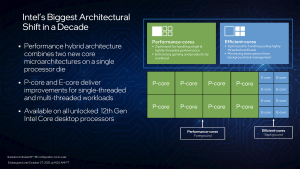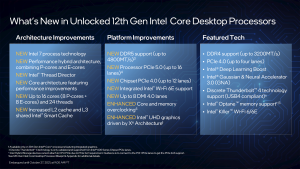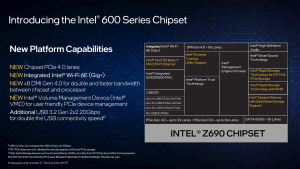After months of leaks and rumours, today Intel is officially launching its 12th Gen Core series desktop processors, otherwise known as Alder Lake. With Alder Lake, Intel is making a major transition, introducing a hybrid architecture that combines performance and efficient cores to elevate performance across all major categories. Beyond that, this new generation brings support for the latest standards, including DDR5 memory and PCIe 5.0.
Each Intel Alder Lake CPU is broken up into Performance cores, otherwise known as P-cores, and Efficiency cores, otherwise known as E-cores. The former are optimised for single and lightly-threaded workloads, while the latter are optimised for scaling highly-threaded workloads. The Intel Thread Director helps monitor these cores and analyses performance data in real-time, ensuring the right cores are being used by applications. All of this happens in the background, but for the end user, it should result in better performance across professional and creative applications, as well as games.
Other core features from this new generation of processors include up to 16 PCIe 5.0 lanes, an additional 4 PCIe 4.0 lanes, DDR4 and DDR5 memory support, as well as Intel Xe UHD integrated graphics. The Intel 12th Gen series is launching with six SKUs at first, with both K-series and KF-series versions, the main difference between the two being the lack of integrated graphics in KF chips. You can see specifications in the table below:
| Processor | Cores (P+E) | Threads | P-core base frequency (GHz) | E-core base frequency (GHz) | P-core max Turbo frequency (GHz) | E-core max Turbo frequency (GHz) | Processor base power (W) | Maximum Turbo power (W) | Price (£) |
| i9-12900K | 16 (8P+6E) | 24 | 3.2 | 2.4 | 5.1 | 3.9 | 125 | 241 | 599 |
| i9-12900KF | 16 (8P+6E) | 24 | 3.2 | 2.4 | 5.1 | 3.9 | 125 | 241 | 579 |
| i7-12700K | 12 (8P+4E) | 20 | 3.6 | 2.7 | 4.9 | 3.8 | 125 | 190 | 419 |
| i7-12700KF | 12 (8P+4E) | 20 | 3.6 | 2.7 | 4.9 | 3.8 | 125 | 190 | 389 |
| i5-12600K | 10 (6P+4E) | 16 | 3.7 | 2.8 | 4.9 | 3.6 | 125 | 150 | 299 |
| i5-12600KF | 10 (6P+4E) | 16 | 3.7 | 2.8 | 4.9 | 3.6 | 125 | 150 | 269 |
All K-series processors use the same Intel UHD Graphics 770, while the cheaper KF chips come without an iGPU. For the Core i9-12900K and Core i7-12700K (and their KF models), you also get Intel Turbo Boost Max 3.0, capable of boosting speeds to 5.2GHz and 5.0GHz respectively.
Alongside these new processors, Intel has revamped its Extreme Tuning Utility, so you can make overclocking adjustments on a per-core basis, and adjust ratio multipliers for both P-cores and E-cores. For a simpler approach to overclocking, there is also the Intel Speed Optimiser, which is a one-click overclocking tool that will adjust P-core and E-core frequency, voltage and other parameters automatically.
We already have some of these processors in-house and ready to test for full reviews. We can't release any performance numbers yet, but Intel's own tests show an up to 19 percent improvement in productivity performance for the Core i9-12900K compared to the Core i9-11900K, as well as major gains in gaming, streaming and content creation.
For more on our early impressions of Intel Alder Lake and the Z690 chipset, be sure to check out Leo's video, HERE.
Discuss on our Facebook page, HERE.
KitGuru Says: Intel's 12th Gen processors have arrived – stay tuned for reviews coming soon! In the meantime, let us know what you all think of Intel's new line-up so far.
 KitGuru KitGuru.net – Tech News | Hardware News | Hardware Reviews | IOS | Mobile | Gaming | Graphics Cards
KitGuru KitGuru.net – Tech News | Hardware News | Hardware Reviews | IOS | Mobile | Gaming | Graphics Cards






